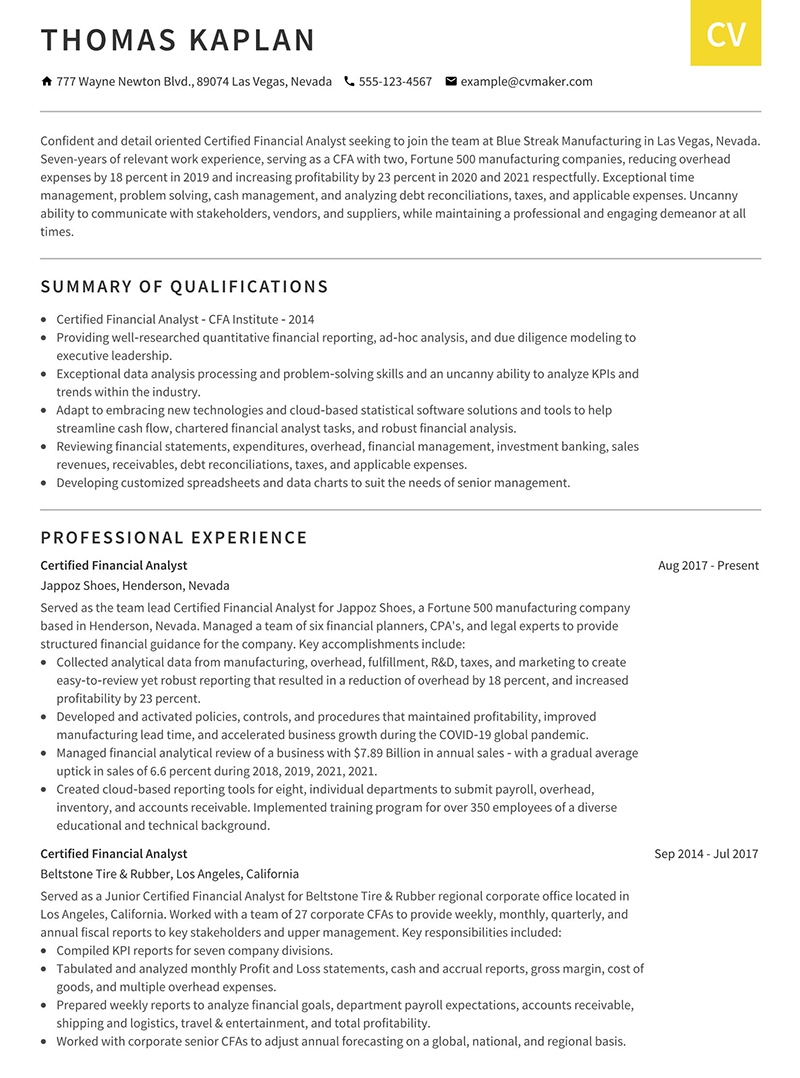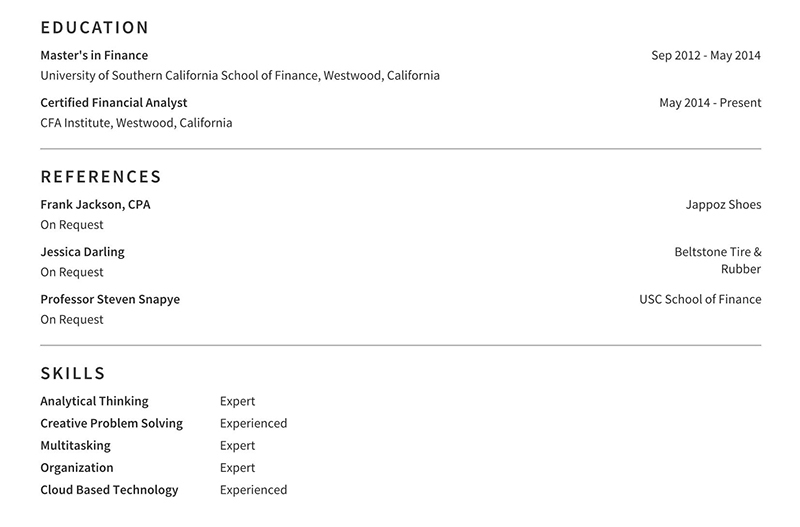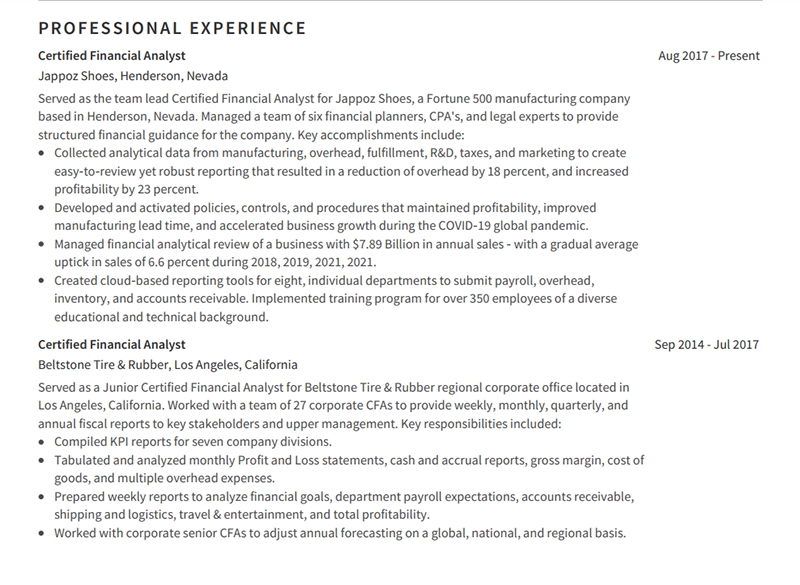Financial Analyst Resume Example & How to Write Tips for 2024
The analysts who provide raw data and guidance for financial planning are a vital component of the global market. And while this industry is evolving, there will always be a need for financial analysts - especially in the United States. However, to retain a top-flight job, you'll have to draft an elegant and engaging financial analyst resume.
The global financial industry is the bedrock that provides sustainability for daily living. Whether a business or individual is blessed with a financial windfall or live paycheck-to-paycheck, the main objective of financial planning or financial modeling is to grow wealth through strategic investments and the allocation of funds.
While several financial analyst positions are available in 2022, there are just as many qualified candidates looking to retain that perfect position. Those who can submit a dazzling and well-structured financial analyst skills resume will hold a competitive advantage over other candidates.
So – this brings up the ultimate question; how do you write a great financial analyst job description resume? Are there financial analyst resume examples that will provide a practical roadmap for candidates of multiple levels?
What is the valuation criteria a hiring manager or recruiter want to see on a resume? Should you include the education you're currently enrolled in, or are there specific requirements for content that all entry-level resumes should include?
These are a few of the questions we'll answer in the article below.
Financial Analyst Resume Sample
The financial analyst is responsible for forecasting future revenue-generating opportunities for businesses and individuals, creating cost structures, and operating expenses, and determining the best allocation of funds to ensure financial strength and integrity. This position requires secondary education, practical experience, and extreme attention to detail.
You should embrace these same attributes when preparing to write a financial analyst resume template. However, before we get too deep into the weeds about organizing, formatting, choosing the proper vocabulary, selecting the right work experience and other resume writing tips – let's first have you review one of our best senior financial analyst resume samples.


A resume that flows from start to finish and tells a story is what you should strive to replicate. The sample resume above is an excellent example of this. The hypothetical resume above is for a candidate named Thomas, applying for a senior financial analyst position at a manufacturing company in Las Vegas, Nevada.
The resume is two pages long, which is enough to provide additional information to the prospective employer. A resume should always be a supporting document to the application – with information matching 100% in each section. This means the contact information on the resume should be exactly what you've listed on the application and cover letter. This also applies to the work history section, education, skills, and references.
This is the consistency and attention to detail sought after in most financial analyst positions. By displaying it in the resume, application, and cover letter, you provide the employer with a real-world example of your skill.
How to Write a Good Resume for Financial Analyst in 2024: Financial Analyst Resume Guide
A good plan is crucial to writing an engaging financial analyst resume. Regardless of the industry or the type of resume you're creating, we strongly suggest using a master resume – or creating a working Word document that allows you to outline the entire resume from start to finish.
The first thing you should do is create a new document and write down the following primary sections.
Personal Contact Information: This will include your full legal name, mailing address, email, and mobile phone number. Unless the job posting requires more information, you should keep this area simple – and as we stated above – make sure it's identical to the contact information listed on your cover letter and application.
Professional Summary: The following section on your master resume is the professional summary. This is your elevator pitch that briefly – yet convincingly introduces your candidacy to the prospective employer.
Summary of Qualifications: This is the section where you list key bullet points of the qualifications you have that will make you a great contributor to the company as a financial analyst. These would include experience analyzing economic trends, policy and political climate, government regulations, financial laws and securities, and more.
Work History: The work history will showcase your previous financial analyst or financial planning positions. This section will include a few bullet points of critical accomplishments at each position. It's best to select your two most recent financial analyst jobs that highlight decision making and years of experience.
Education: This section is straightforward. List your highest completed education.
References – It's best to select three contacts – two professional and one personal.
Skills: The final section of your resume is the skills section. Select the top 5 or 6 hard or soft skills that make you a great financial analyst. We will explain more in the sections below.
The items in bold type should be your primary sections listed on the master resume in order. You can then add relevant content based on the sample resume sections we'll post below. Let's start the journey by explaining what you should add in each section below.
Section #1 – Contact Information
We spoke about the importance of attention to detail as a financial analyst. Those who select candidates to fill these open job positions also possess the same skills. Like a balance sheet, it's vital to start your resume on the right foot, using the right metrics – and that begins with the first section, your personal contact information.
Include your full legal name, mailing address, email, and mobile phone for a financial analyst position. The main reason why you should include a mobile device is two-fold. First, you can and should connect your email to your mobile device. Second, you need to make sure your mobile device has SMS text notifications.

The main reason for this is that modern recruiting and HR firms hire financial analysts for a business using automated software solutions that contact candidates via email or text notification. If you don't reply quickly to those notifications, the firm will likely skip you and move forward to other qualified candidates.
How to Format this Section
The contact information section is simple – and should be easy for the resume reader to review. The best way to format this section is to use a great resume builder, such as CVMaker.com. Add the information to the resume builder, or manually enter your name, your mailing address, and your email and mobile number. Also, make sure all information matches what you’ve listed on your job application and cover letter.
Section #2 – Professional Summary
The first section most hiring managers read is the professional or resume summary. It's also a section where automated software programs scan for keywords or action verbs that apply to financial analyst positions.

As you can see in the sample section posted above, our candidate Thomas has written a customized and personalized summary of the company he is hoping to join. He introduces his years of practical experience, some of his key accomplishments, and the interpersonal skills that make him a great member of the company.
The keywords you should include in the resume summary are risk management, corporate finance, strategy development, financial accounting, and documentation or reporting of financial data.
How to Format this Section
The best practice for a financial analyst resume objective is to keep it below 200 words – or four to five well-written sentences. It's best to write it in a professional yet conversational tone, using plenty of powerful keywords and interpersonal skills.
Section #3 – Summary of Qualifications
There is some debate among professional resume writers about the summary of qualifications section of a resume for financial analysts and other finance industry positions. Some suggest keeping the resume to a single page – focusing mainly on relevant work history and showing previous success stories.
Others believe the summary of qualifications section permits the candidate an excellent opportunity to showcase their strengths that apply to being a solid financial analyst. This is a section that we'll say is 100% optional to you.

If you're going to use the summary of qualifications section, your goal should be to list five to seven specific skills that you possess that are relevant to this industry. If you review Thomas' sample resume above, you'll see that he included this in his financial analyst skills resume. He has used several specific qualifications, including:
- Providing well-researched quantitative financial reporting, ad-hoc analysis, and due diligence modeling to executive leadership.
- Exceptional data analysis processing and problem-solving skills and an uncanny ability to analyze KPIs and trends within the industry.
- Adapt to embracing new technologies and cloud-based statistical software solutions and tools to help streamline cash flow, chartered financial analyst tasks, and robust financial analysis.
- Reviewing financial statements, expenditures, overhead, financial management, investment banking, sales revenues, receivables, debt reconciliations, taxes, and applicable expenses.
- Developing customized spreadsheets and data charts to suit the needs of senior management.
How to Format this Section
Our recommendation is to format this section with bullet points. The sample above shows how this section should appear on a resume.
Section #4 – Work History
As a financial analyst, you understand the importance of reviewing applicable data. The same concept applies to listing the work history you've had when writing the resume. Future employers need to review previous jobs in the same industry – to determine whether you're a good fit for their firm or company.

As you can see in Thomas' resume, he has listed two previous financial analyst positions. They are listed in reverse chronological order and showcase his key accomplishments achieved during his time with both companies. For lack of a better term, he focuses on success stories – providing the company or hiring manager with practical, relative data to make an informed decision.
How to Format this Section
We recommend choosing two of your most recent financial analyst positions to list on your resume and application. Make sure that both documents include the previous jobs – as this again helps showcase your consistency and attention to detail. Always list the company's name, the location, and the dates. You should also document a few key bullet points of tasks, duties, or accomplishments.
Section #5 – Education
Many of today's top Financial Analyst positions will require an MBA degree. It is essential to verify with the job posting to ensure you have the required education. However, the education section is not intended to display what is required – but what you've completed. For example, if the financial analyst position requires a bachelor's degree and you have an MBA, you need to document your MBA and any relevant certifications from the CFA Institute.

This is what our candidate Thomas has done with his CFA resume. He has listed his MBA first, then notated his active certification on the second line.
How to Format this Section
The education section of every resume should be kept simple. List the name of the school in which you graduated, location, dates of attendance, and the degree earned. With the certification, list the date of your official acceptance into the CFA Institute.
Section #6 – References
One of the most challenging decisions a hiring manager must make is choosing between two equally qualified candidates. If there is a tie-breaker section of a resume – the references selected may be the best option. Your references can help you gain the job – if they are the right ones for the position you have applied to.

A reference intends to provide credibility and support to the information you've listed on the application and resume. They are designed to provide practical input about your ability to forecast sales, plan budgets, and recommend financial investments. They also vouch for your personality, professionalism, and work ethic.
How to Format This Section
We strongly recommend choosing three references – two of them who are professional and work in the financial space, and one that can serve as a personal reference. Due to privacy concerns, it's best to list your reference's full name, place of employment (or where you know them from), and the phrase "upon request" on the resume. Do NOT list their private contact information on a resume. Provide those details to the hiring agency or manager if requested.
Section #7 - Skills Section
If you listed your summary of qualifications, the skills section could be reduced or skipped altogether. The skills section is your chance to publish your strengths – mainly soft skills, such as work ethic, time management, attention to detail, strong analytic skills, and more. Using a resume builder will reduce the struggles of formatting skills, as they'll allow you to format on the bottom or sidebar of the document.

Other Finance Resume Templates
Along with reviewing senior financial analyst resume samples – taking time to read other financial industry resumes or templates can provide you with practical tips. All financial jobs require candidates to maintain a specific set of skills often spread throughout the industry. When you can read practical templates and samples – relevant to this industry – it can plant seeds of knowledge that you can infuse into your resume.
If you are looking for professionally written resumes, we've collected several for review in the direct links posted below.
Final Points on Writing Financial Analyst Resumes
The best financial analysts have a unique way of collecting data, segmenting it, and formulating financial advice that helps their clients maintain or expand wealth. While experience and a solid application, cover letter, and interview will allow you to retain the best jobs, an engaging resume can help you eclipse any hurdles.
Here are some final thoughts to remember when writing and formatting the resume.
- Start by using a Master Resume to outline, insert content, edit, and optimize.
- Make sure your resume has a natural flow and is written with a conversational tone.
- Always write your resume on a plain white background with black font.
- Edit the document SEVERAL TIMES – through Grammarly.com and visual inspection.
- Ensure its well-spaced, organized, and professional.
- Finally, read it aloud a few times before you're ready to paste everything into your resume builder.
Always remember to write your resume with a professional yet conversational tone. Don't be afraid to showcase some personality within the content; always sprinkle in those key action verbs, and proofread the financial analyst resume before printing the final document.